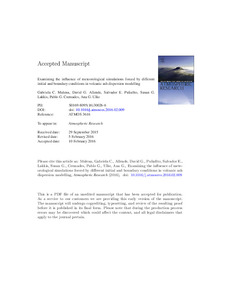Por favor, use este identificador para citar o enlazar este ítem:
https://repositorio.uca.edu.ar/handle/123456789/5498| Título: | Examining the influence of meteorological simulations forced by different initial and boundary conditions in volcanic ash dispersion modelling | Autor: | Mulena, Gabriela C. Allende, David Puliafito, Salvador E. Lakkis, Susan Gabriela Cremades, Pablo G. Ulke, Ana G. |
Palabras clave: | CENIZA; DISPERSION; METEOROLOGIA; MODELOS; SIMULACION | Fecha de publicación: | 2016 | Editorial: | Elsevier | Cita: | Mulena, GC., Allende, DG, Puliafito, SE, Lakkis, SG, Cremades, PG. Ulke, AG. Examining the influence of meteorological simulations forced by different initial and boundary conditions in volcanic ash dispersion modelling [en línea]. Atmospheric research, 2016:176-177(1). doi:10.1016/j.atmosres.2016.02.009 Disponible en: https://repositorio.uca.edu.ar/handle/123456789/5498 | Resumen: | Abstract: The performance of the combination of the Fall3D ash dispersion model with the Weather Research and Forecast (WRF) meteorological model in the southern cone of South America under two initial and boundary conditions was evaluated. ERA-Interim and NCEP-GFS databases were used as dynamic conditions by WRF to simulate meteorological fields for FALL3D. As a case study, we used the eruption of the Puyehue-Cordón Caulle Volcanic Complex occurred in Chile in June 2011. The simulated meteorological results were compared with the horizontal wind direction, meridional and zonal wind components, air and dew point temperatures of 7 radio sounding stations using a set of error indicators. In addition, the ash mass load simulated by FALL3D for a day of maximum dispersion of volcanic ash was evaluated using the Moderate Resolution Imaging Spectroradiometer (MODIS), on which the Prata algorithm was applied. As well as this, the WRF dominant physical processes with both dynamic conditions were analyzed for that same date. Meteorological results indicated that the simulation performed with WRF and NCEPGFS shows the lowest errors at levels between 925 hPa and 300 hPa. Ash dispersion simulated with FALL3D and WRF in both dynamic conditions shows a different perfomance, which from the synoptic and dynamic viewpoint can be explained for the result of wind intensity and geopotential height. Moreover, WRF intiliazed with NCEPGFS and FALL3D has a higher degree of concordance with the MODIS image. Based on the analysis and results, it was concluded that for the southern cone of South America: 1) it was not trivial for the simulation of volcanic ash dispersion to use one dynamic condition or another in WRF; 2) in that sense, meteorological variables that influenced the differences in volcanic ash dispersion were horizontal wind intensity and direction and geopotential heights; 3) the system generated from the combination of the WRF model initialized with NCEP-GFS and the FALL3D dispersion model would provide better estimations of ash plume position and deposition in the region | Cobertura Espacial: | AMERICA DEL SUR | URI: | https://repositorio.uca.edu.ar/handle/123456789/5498 | ISSN: | 0169-8095 | Disciplina: | INGENIERIA AMBIENTAL | DOI: | 10.1016/j.atmosres.2016.02.009 | Derechos: | Acceso Abierto | Fuente: | Atmospheric Research 176-177(1), 2016 |
| Aparece en las colecciones: | Artículos |
Ficheros en este ítem:
| Fichero | Descripción | Tamaño | Formato | |
|---|---|---|---|---|
| examining-influence-meteorological-lakkis.pdf | 2,49 MB | Adobe PDF |  Visualizar/Abrir |
Visualizaciones de página(s)
279
comprobado en 12-dic-2025
Descarga(s)
597
comprobado en 12-dic-2025
Google ScholarTM
Ver en Google Scholar
Altmetric
Altmetric
Este ítem está sujeto a una Licencia Creative Commons

